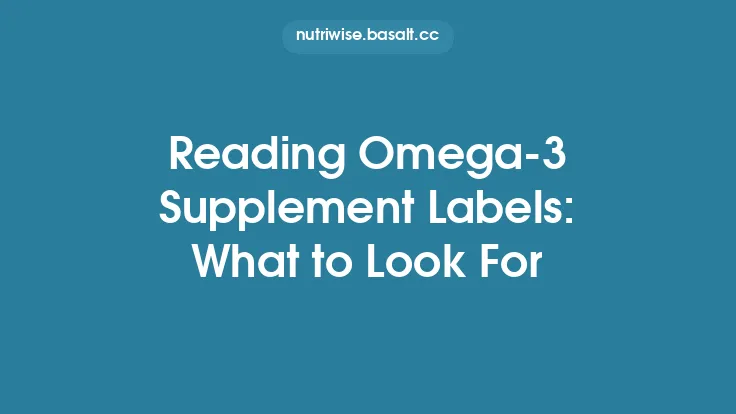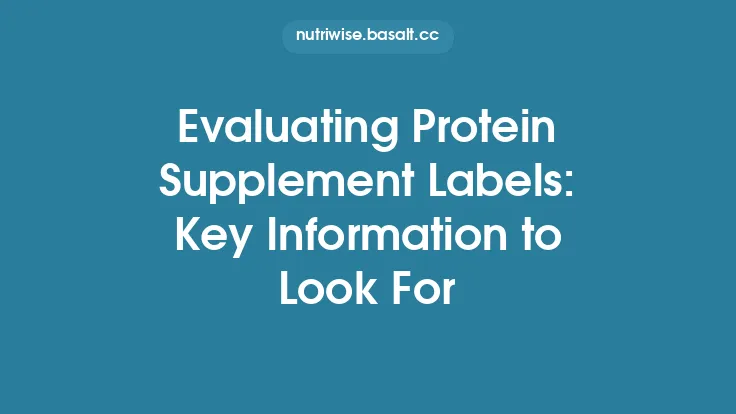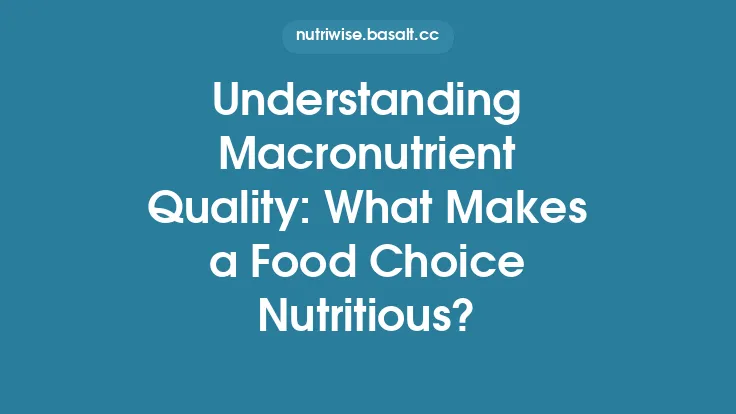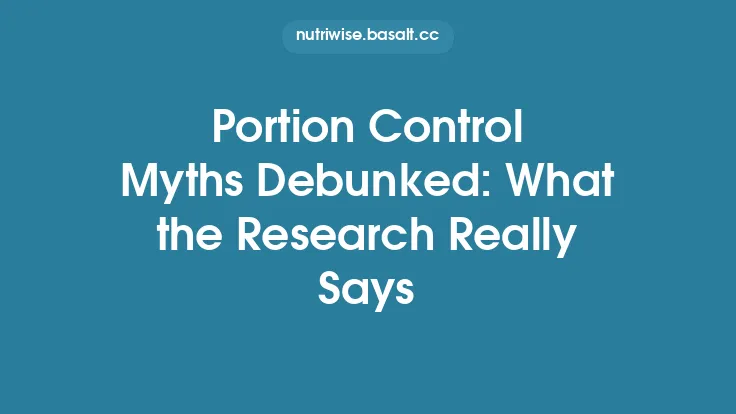Adaptogen supplements have surged in popularity as consumers seek natural ways to support their bodies under stress. While the promise of “stress‑relief” and “energy‑boosting” can be enticing, the true value of a product lies in the details printed on its label. Understanding those details empowers you to choose high‑quality adaptogens that deliver consistent benefits and avoid hidden pitfalls.
Decoding the Ingredient List
Botanical name vs. common name
A reputable label will list the scientific (Latin) name of each herb alongside its common name (e.g., *Panax ginseng* – Asian ginseng). This reduces ambiguity, especially when multiple species share a vernacular name.
Part of the plant used
Adaptogenic compounds are often concentrated in specific plant parts—root, leaf, berry, or rhizome. The label should specify which part is present, because potency can vary dramatically. For instance, the root of *Rhodiola rosea* contains higher concentrations of rosavins than the aerial parts.
Extract type and ratio
Many adaptogens are sold as extracts rather than raw herb powders. Look for a clear extraction ratio (e.g., 10:1, 5:1). A 10:1 extract means ten parts of raw material were used to produce one part of the final extract, indicating a higher concentration of active constituents. The extraction solvent (water, ethanol, CO‚ÇÇ) should also be disclosed, as it influences which phytochemicals are retained.
Standardized to active markers
Standardization guarantees that each batch contains a minimum amount of key bioactive compounds. Common markers include:
| Adaptogen | Primary marker(s) | Typical standardization range |
|---|---|---|
| *Ashwagandha (Withania somnifera*) | Withanolides | ‚â•5% |
| *Rhodiola (Rhodiola rosea*) | Rosavins & Salidroside | ‚â•3% rosavins, ‚â•1% salidroside |
| *Siberian Ginseng (Eleutherococcus senticosus*) | Eleutherosides | ‚â•0.8% |
| *Schisandra (Schisandra chinensis*) | Schisandrins | ‚â•2% |
If a product claims “standardized” but does not list the specific marker or percentage, treat it with caution.
Understanding Purity Claims
Organic certification
An “USDA Organic” or equivalent certification indicates that the herb was grown without synthetic pesticides, herbicides, or genetically modified organisms. Verify the certification logo and the certifying body’s code.
Non‚ÄëGMO verification
For adaptogens sourced from crops prone to genetic modification (e.g., *Panax ginseng*), a non‚ÄëGMO statement backed by a third‚Äëparty test can be reassuring.
Heavy‚Äëmetal and microbial testing
Adaptogenic herbs can accumulate soil contaminants. Look for explicit statements such as “tested for lead, arsenic, cadmium, and mercury below FDA limits” or “free of E. coli, Salmonella, and mold.” The best practice is a label that cites a third‑party laboratory (e.g., NSF, Eurofins) with a batch‑specific certificate of analysis (COA) available on request.
Allergen disclosures
Even if the adaptogen itself is allergen‚Äëfree, the manufacturing environment may introduce cross‚Äëcontamination. Labels should list any potential allergens (e.g., soy, gluten, dairy) present in the capsule or tablet matrix.
Evaluating Manufacturing Transparency
Good Manufacturing Practices (GMP) compliance
A statement that the product is manufactured in a GMP‑certified facility signals adherence to quality control standards. Look for the facility’s registration number (e.g., FDA 21 CFR 111) or a recognized international GMP certification (e.g., ISO 22000).
Batch or lot numbers
Including a batch/lot number on the label allows traceability. If you need to verify a COA, you can reference that specific batch rather than a generic product claim.
Expiration date and stability
Adaptogenic compounds can degrade over time, especially if exposed to heat, light, or moisture. An explicit “Best if used by” date is essential. Some high‑quality brands also provide storage instructions (e.g., “store in a cool, dry place away from direct sunlight”) to preserve potency.
Dosage Form Considerations
Capsules vs. tablets vs. powders
Each form has distinct implications for bioavailability and stability:
- Capsules (especially vegetarian or gelatin‚Äëfree) protect sensitive extracts from oxidation.
- Tablets may contain binders and fillers that could affect absorption; look for “tablet‑bound” claims that specify minimal inert ingredients.
- Powders allow flexible dosing but are more susceptible to moisture; a sealed, opaque container is a good sign.
Fillers, binders, and flow agents
High‚Äëquality labels will list any excipients and keep them to a minimum. Common benign fillers include rice flour, maltodextrin, or microcrystalline cellulose. Avoid products that rely heavily on artificial colors, flavors, or sweeteners unless they are clearly disclosed.
Third‚ÄëParty Verification: The Gold Standard
NSF Certified for Sport
While primarily aimed at athletes, this certification also confirms that the product is free from prohibited substances and contains the declared ingredients at the stated levels.
USP Verified
The United States Pharmacopeia (USP) verification indicates that the supplement meets stringent criteria for purity, potency, and manufacturing practices.
ConsumerLab or Labdoor testing
Independent labs periodically test popular supplements and publish results. A label that references a recent test (including a link or QR code to the report) demonstrates confidence in product integrity.
Red Flags to Watch For
- Vague “proprietary blend” without disclosure – This can mask low levels of active ingredients.
- Absence of standardization or marker percentages – May indicate inconsistent potency.
- No batch number or expiration date – Hinders traceability and safety.
- Excessive filler list – Could dilute the adaptogenic content.
- Claims of “miracle” results or “clinically proven” without citation – Look for peer‑reviewed references or FDA‑approved health claims.
Practical Checklist for the Savvy Consumer
| Item | What to Look For | Why It Matters |
|---|---|---|
| Botanical name | Latin name + common name | Confirms exact species |
| Plant part | Root, leaf, berry, etc. | Determines active profile |
| Extraction ratio | e.g., 10:1, 5:1 | Indicates concentration |
| Standardization | Marker % (e.g., ‚â•5% withanolides) | Guarantees potency |
| Organic / Non‚ÄëGMO | Certified logos | Reduces pesticide/GM risk |
| Heavy‚Äëmetal & microbial testing | Explicit statements + COA | Ensures safety |
| Allergen info | Full disclosure | Prevents adverse reactions |
| GMP compliance | Facility code or certification | Assures manufacturing quality |
| Batch/lot number | Present on label | Enables traceability |
| Expiration date | Clearly printed | Guarantees efficacy |
| Third‚Äëparty seal | NSF, USP, ConsumerLab, etc. | Independent verification |
| Excipient list | Minimal, natural fillers | Reduces unnecessary additives |
By systematically reviewing these label elements, you can differentiate between a rigorously produced adaptogen supplement and one that relies on marketing hype. High‑quality adaptogens, when sourced and processed correctly, deliver consistent levels of the phytochemicals that support the body’s stress response. The label is your first line of assurance that the product you’re purchasing lives up to that promise.





